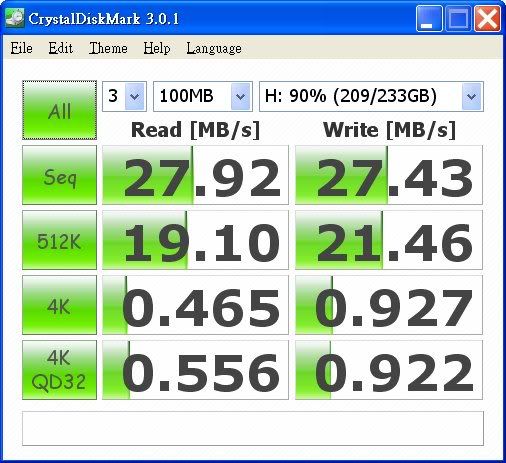
Test Conditions and Procedures:-
1. Latest version (3.0.1) of the Crystal Disk Mark was used, which the standalone executable version in zip format can be got there;
2. Each card was freshly formatted in-camera right before carrying out each test;
3. Connected the K-5 via original dedicated USB cable, battery indication of camera was Full;
4. PC Platform: Intel E8300 Core2Duo at 2.83GHz, Windows XP Professional SP3;
5. Tested for 3 times and the best results were obtained, total data transfer size was 100MB;
Test Results:-
| Card (Make/Model/Class) | Sequential Read** (MB/s) | Sequential Write* (MB/s) | Random 512k Read (MB/s) | Random 512k Write (MB/s) | Random 4k Read (MB/s) | Random 4k Write (MB/s) | Screen Capture of Test Results |
| Sandisk Extreme 16GB HD Class 10/I | 11.66 | 8.940 | 11.67 | 2.841 | 2.711 | 0.828 | View |
| Sandisk Ultra 16GB Class 4 | 12.13 | 5.924 | 12.08 | 1.163 | 2.883 | 1.417 | View |
| Sandisk Standard 8GB Class 4 | 7.776 | 4.283 | 7.770 | 1.262 | 2.378 | 0.905 | View |
| Transcend 8GB Class 6 | 12.57 | 7.075 | 12.58 | 2.133 | 3.870 | 0.029 | View |
| Kingston 8GB Class 4 | 9.881 | 5.828 | 9.821 | 0.671 | 2.485 | 0.006(!) | View |
| Toshiba 2GB Class 6 | 12.03 | 9.029 | 12.04 | 6.242 | 3.199 | 0.153 | View |
| Toshiba 2GB Class 6 (on GF1***) | 8.237 | 6.456 | 8.271 | 4.830 | 1.344 | 0.136 | View |
| Kingston 1GB Class-less (Reference Baseline) | 6.527 | 2.531 | 6.526 | 1.456 | 2.656 | 0.026 | View |
Remarks:-
* Sequential Write is the most important performance figure as most digital image and video files are usually written sequentially.
** Sequential Read affects playback time for review and determine the time for copying/moving back the image/video files from memory card to computer.
*** GF1 is also tested with the Toshiba 2GB "White Card" as it seems to perform very well in K-5 despite its age. The performance difference between the two cameras is then checked and compared. It seems that the K-5 is roughly about 50% faster than the GF1 for both reading and writing.
Update (2-23): Some people have questioned about the speed of USB of being the "limiting" factor in my test. But as I've already replied in the Comments section below, USB 2.0, which the K-5 uses, had a maximum transfer rate of 480 Mbps (Mega bits per second) in its designed specifications which is close to 60MB/s (Mega Bytes per second) roughly (assuming 1M = 1,000,000 bits and the simple fact that 1 Byte = 8 bits).
To further prove that the USB is not the bottle neck but the camera plus the card should be, the following simple test has been done for verification. I've connected an external hardisk drive with an USB 2.0 interface, via a cheap SATA-to-USB2.0 adapting case. Here is the result of the harddisk under test, which is just a typically slow 5400 rpm "250GB" one:-

All in all, the above quick test and result actually safely disproves all the unsubstantiated claims of suspecting that the USB is "not fast enough". Even if a slow harddisk with a cheap external casing can do nearly 30MB/s for both the sequential read and write! I am almost sure that if I use a better adapting case with a faster harddisk and re-do the same test again with the disk freshly formatted, the throughput rate can be even higher (and note that my that harddisk under test above is nearly full at 90% spaced used). So, the *bottle neck* must NOT the USB, but the camera+card as a whole instead!
Nevertheless, I do yet agree that the USB does incur some additional overhead in operation and thus would induce some performance loss than the real speed of the cards which could be higher, when they are read and written direclty in-camera. However, the difference should NOT be highly significant against what have been imagined and that it should be noted that it is an apple-to-apple fair comparison of this test. Furthermore, I just wish to ask what other method(s) else could do the measurement more accurately and realistically? (Not even to say to do it easily!) :-o